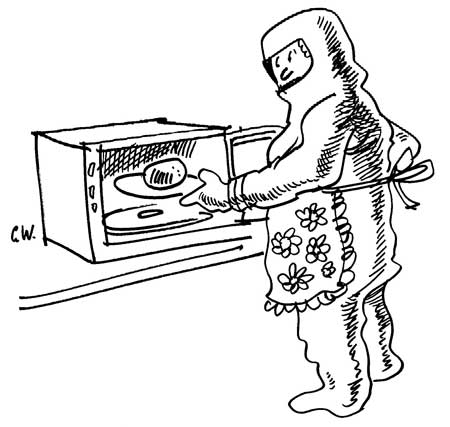|
|
Microwave technology: a twenty-first century Trojan horse by John Scott |
|
|
|
Microwaves and health This emits a distinctive sound for each type of radiation that it picks up – eg from phone mast, DECT device or Wi-Fi – each of which can be identified by listening to the sample sounds. The most aggressive radiation in many homes comes from the base (docking-station) of a Digital Enhanced Cordless Telecommunications (DECT) telephone system. These typically irradiate the inside of a house more highly than even a mobile phone mast – and not just when a phone is in use, but the whole time that the base station is switched on. This radiation also reaches into adjacent homes, raising health risks for neighbours. (Read more on the
dangers of DECT.)
• Choose a phone with a long 'talk time', which is indicative of greater efficiency. It should also be advantageous to use a phone with a low SAR (specific absorption rate, which is a measure of the amount of radio frequency energy absorbed by the body when using a mobile phone), although the SAR is not an entirely reliable measure of phone safety, as some high SAR phones can actually be very efficient and work at low power, whereas some low SAR phones can be inefficient and work at high power. Wi-fi and bluetooth
If the use of an Electro-
smog Detector indicates
that external microwave
radiation is a problem in
a particular home,
shielding materials are
available to reduce exposure. Special wall paint, and fabrics for use as curtaining, can be
obtained from EMFields (www.emfields.org) where you can also find more information on shielding and related topics. Still further advice and additional shielding products are available from the US EMF Safety Superstore.
It is wrong to assume that the radiation produced by micro-wave ovens is all kept within the confines of the oven's metal shell. Holding an Electrosmog Detector several feet away from a microwave oven will reveal that microwaves are in fact
spread into the vicinity of the oven during use, and typically
extend for several feet. It is therefore wise to What is happening outside the oven is, however, only part of the problem with this type of cooking, which is, technically, a form of food irradiation. Indeed, the first microwaves were proudly advertised as 'radar ranges', when they were introduced in the 1970s. Equipment Sources The Healthy House The US EMF Safety Superstore (carries a huge range of protection options) www.lessemf.com Further Information
Update – January 2010 In the twelve months since the above piece was written, there have been a number of significant developments in parts of the world where governments which are not as much in the pockets of the telecoms industry as they are in the UK and the US have begun to take action to raise awareness about the risks of microwave radiation and to protect their citizens by introducing legislation. January 2009. France introduced new laws - the strictest so far in Europe - banning all advertising of mobile phones to children under 12, and the sale of any phones designed to be used by those under six. The French government is also to introduce new limits for radiation from phones and make it compulsory for handsets to be sold with earphones, so that users can avoid irradiating their heads and brains. May, 2009. Following publication of a report suggesting that mobile phones and Wi-Fi can damage the developing brain, the French government went even further by banning these technologies from every primary school in the country. June 2009. The European Parliament declared itself to be greatly concerned by the international Bio-Initiative report on electromagnetic fields (http://www.bioinitiative.org/report/index.htm), which highlights the health risks posed by emissions from devices such as mobile telephones, UMTS, Wi-Fi, Wimax and Bluetooth, as well as DECT wireless telephones. Declaring the current limits on exposure obsolete, they have adopted a resolution calling on the European Council to set stricter exposure limits for all equipment which emits electromagnetic waves in the frequencies between 0.1 MHz and 300 GHz. The European Parliament has also issued a press release about the dangers which these technologies pose for citizens. August 2009. Liechtenstein and Switzerland announced their intention to drastically reduce RF radiation exposure limits. October 2009. The French believe the biological effects of exposure to RF radiation are now beyond doubt. December 2009. France leads the way in reducing RF exposure and a US Senate hearing confirms mobile phone dangers. In spite of all this activity elsewhere, the UK government has so far still made no attempt whatsoever to protect its citizens from radio-frequency radiation, or even to warn them about the risks, and UK consumer organisations, such as the Consumer's Association (publishers of Which? magazine), appear to have their heads well buried in the sand on this issue. In the absence of responsible guidance, the UK population can't get enough of this Trojan horse, as the madness continues with the latest craze - wireless internet - which will further intensify the haze of microwave radiation to which we are all exposed.
|














